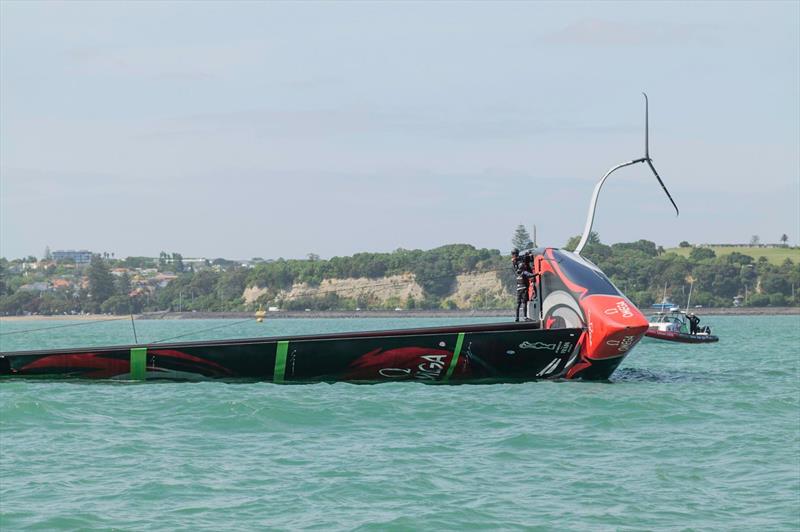
America's Cup: Dramatic capsize video of Team NZ's AC75
by Richard Gladwell Sail-World.com/nz 18 Dec 2019 17:07 PST
19 December 2019

Emirates Team New Zealand in the early stages of being righted with the towline under tension over a chafe pad on the gunnel - Waitemata Harbour - December 19, 2019 © Emirates Team New Zealand
Emirates Team New Zealand became the first team to capsize their AC75 yacht in an incident this morning.
The incident was dismissed by the team as "A little whoopsie on the Waitemata, upright again and back into it. All part of learning..."
Speaking with a team spokesman, the incident happened off North Head at the entrance to the Waitemata Harbour as the team set up for another training session.
Winds were only about 10kts at the time and a condition where the AC75 does about 4x windspeed.
The team were foiling at probably 30kts and had just turned through a gybe when there appeared to be an issue with the wing control system, with the new windward wing producing more lift than the new leeward wing, causing the 75ft foiling monohull to rear spectacularly.
In the most surprising aspect of the incident, after going near completely airborne, Te Aihe falls several metres to land at a not abnormal angle of heel for the AC75 in displacement mode, and still sailing at several knots. This position is one from which she should have been able to continue sailing.
However, instead of shaking herself off and continuing, Te Aihe then starts to skid on the water and then starts a slow roll to leeward even with her carbon foiling arm and wing, weighing 1215kg, fully deployed to windward - in its standard operating position from which it gives maximum righting moment. However such was the force being applied to leeward (probably from the other foil) that all the windward counterweight could do was to slow the rate of roll to leeward until the capsize was complete.
The AC75 came to a resting position on its side, before being righted, with the assistance of the chase boat and continued with the sailing session. The likely causes of the incident are either operator error or a software malfunction.
Helmsman Peter Burling dismissed the incident: "we were pushing the boat super-hard around a few marks and we ended up making a little mistake at the end of a gybe and rolled it over, in a light breeze. When you push the boundaries as hard as you can in the practice, it is going to happen at some stage and we are really happy with the way we got it back upright, and just carried on sailing for the rest of the day."
The team was spotted later this morning off Auckland's North Shore, before heading to a regular training session in "The Paddock" off Auckland's Eastern Beach - a strong indication that there was no damage sustained in the incident, and the AC75 had stayed watertight.
Emirates Team New Zealand trained for a further four hours after the capsize in 15-18kt winds, before towing home.
The incident, while unfortunate, expunges any doubt about the consequences of a capsize incident in the high-powered AC75. The video shows the boat performs as designed in a capsize situation, and is quite recoverable and ready to race - without any of the drama that accompanied the nosedive of the team's AC50 in Bermuda on the second day of the Challenger Semi-Finals.
The incident also provides valuable real event data for the designer and simulator - a serious Christmas present for the design team.
The data will be analysed to determine exactly what caused the capsize, and compared with data from similar incidents that followed a similar pattern, in stronger winds which but didn't carry through to a capsize. The other area for the designers will be to establish warning systems ahead of the AC75 "red-lining" in this way. And in the current America's Cup with its heavy use of simulators, the team will be able to replay the incident over and over again, to devise a crew response to avoid a full capsize. It will then be a new addition to the playbook in a racing situation, to avoid a re-occurrence in a pre-start or similar pressure situation.
The only issue is that there is only one way of testing the response to this particular scenario - which is to do it again!
From the broader AC75 class point of view, it shows that the America's Cup class while spectacular does perform to design in a catastrophic situation.
It would seem from the subsequent four-hour training session there wasn't a lot of damage to the boat if any. The spars and rigging, which bore a lot of the impact in the capsize, stayed intact. The video shows that it was a textbook recovery.
The carry over into the Prada Cup and America's Cup is that even if one of the competitors capsizes during a race, they should only forfeit that race, and not be out of action for several days - effectively determining the outcome of that phase of the competition or the outcome of the Match itself.
Of course, it remains to be seen whether the other teams push themselves through the same wall - to get the crash data, and then be in a position to make changes to avoid a recurrence in a racing situation.